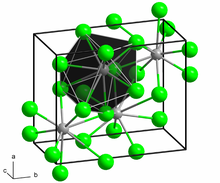Barium chloride
chemical compound
Barium chloride is a chemical substance. It is among the most important salts of barium. It is soluble in water. It is a poison. When it is heated, it gives a yellow or green color to the flame. It is hygroscopic, meaning that it attracts water from the air. It is mainly used to purify brine but applications include fireworks.

| ||

| ||
| Names | ||
|---|---|---|
| Other names | ||
| Identifiers | ||
| ||
3D model (JSmol)
|
||
| ChemSpider | ||
| ECHA InfoCard | 100.030.704 | |
| EC Number |
| |
PubChem CID
|
||
| RTECS number |
| |
| UNII | ||
CompTox Dashboard (EPA)
|
||
| ||
| Properties | ||
| BaCl2 | ||
| Molar mass | 208.23 g/mol (anhydrous) 244.26 g/mol (dihydrate) | |
| Appearance | White solid | |
| Density | 3.856 g/cm3 (anhydrous) 3.0979 g/cm3 (dihydrate) | |
| Melting point | 962 °C (1,764 °F; 1,235 K) (960 °C, dihydrate) | |
| Boiling point | 1,560 °C (2,840 °F; 1,830 K) | |
| 31.2 g/100 mL (0 °C) 35.8 g/100 mL (20 °C) 59.4 g/100 mL (100 °C) | ||
| Solubility | soluble in methanol, insoluble in ethanol, ethyl acetate[2] | |
| -72.6·10−6 cm3/mol | ||
| Structure | ||
| orthogonal (anhydrous) monoclinic (dihydrate) | ||
| 7-9 | ||
| Thermochemistry | ||
| Std enthalpy of formation ΔfH |
−858.56 kJ/mol | |
| Hazards | ||
| Main hazards | Acute Toxic | |
| NFPA 704 |
| |
| Flash point | Non-flammable | |
| U.S. Permissible exposure limit (PEL) |
TWA 0.5 mg/m3[3] | |
| Related compounds | ||
| Other anions | {{{value}}} | |
| Other cations | {{{value}}} | |
Except where otherwise noted, data are given for materials in their standard state (at 25 °C [77 °F], 100 kPa). | ||
| Infobox references | ||
Barium chloride is toxic. Sodium sulfate may be an antidote.
References
change- ↑ Chemical Recreations: A Series of Amusing and Instructive Experiments, which May be Performed with Ease, Safety, Success, and Economy ; to which is Added, the Romance of Chemistry : An Inquiry into the Fallacies of the Prevailing Theory of Chemistry : With a New Theory and a New Nomenclature. R. Griffin & Company. 1834. Archived from the original on 2023-03-13. Retrieved 2023-03-13.
- ↑ Handbook of Chemistry and Physics, 71st edition, CRC Press, Ann Arbor, Michigan, 1990.
- ↑ NIOSH Pocket Guide to Chemical Hazards. "#0045". National Institute for Occupational Safety and Health (NIOSH).
